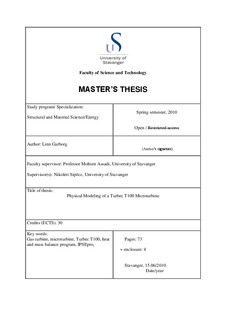| dc.contributor.author | Garborg, Linn | |
| dc.date.accessioned | 2012-02-27T09:05:03Z | |
| dc.date.available | 2012-02-27T09:05:03Z | |
| dc.date.issued | 2010 | |
| dc.identifier.uri | http://hdl.handle.net/11250/182716 | |
| dc.description | Master's thesis in Structural engineering | no_NO |
| dc.description.abstract | The purpose for this thesis is to create a heat and mass balance model of the microturbine, Turbec T100, stationed at Risavika Gas Centre (RGC) in Tananger, Norway. The Turbec T100 at Risavika has some modifications due to research purposes. The combustion chamber is installed outside the casing of the Turbec and there is connected a bypass to it. These modifications also include additional sensors measuring pressure and temperature at the compressor outlet, after the recuperator and at the turbine inlet. The influence of the modifications on the performance of the Turbec is currently not known. By creating a heat and mass balance model the influence of the modifications, if any, can be discovered. With an accurate model of the Turbec T100 at RGC, it is possible to predict the performance data when running on other types of fuel than natural gas.
In order to create the model a literature study regarding the theory and thermodynamics of gas turbines has been carried out. As the Turbec T100 is a microturbine the literature study also involve the concept of microturbines and how they differ from regular gas turbines. A technical description of the Turbec T100 and the one stationed at RGC is also included.
The modeling of the Turbec T100 is done by the heat and mass balance program IPSEpro. A description of how to create a model of a gas turbine and how IPSEpro solves the implemented equations is described step-by-step. One of the tools within IPSEpro is called PSExcel. With this tool it is possible to do variations in a created model and get requested output data presented in an excel work sheet. In this thesis PSExcel has been used to generate data for Mats Mathisen’s master thesis, Noise Filtering from a Nonlinear System by Using AANN.
To validate the model, measurements from RGC was implemented to the heat and mass balance model. IPSEpro calculated the power output and this was compared to the power output measured at Risavika. During the validation process it was revealed that the calculated power output did not correspond to the power output measured at Risavika. The calculated power output was very unstable and, surprisingly, the unit became power consuming instead of power producing. This indicated that there was some inaccuracy involving the measurements applied to the model. | no_NO |
| dc.language.iso | eng | no_NO |
| dc.publisher | University of Stavanger, Norway | no_NO |
| dc.relation.ispartofseries | Masteroppgave/UIS-TN-IKM/2010; | |
| dc.subject | byggkonstruksjoner | no_NO |
| dc.subject | materialteknologi | no_NO |
| dc.subject | gas turbine | no_NO |
| dc.subject | microturbine | no_NO |
| dc.subject | Turbec T100 | no_NO |
| dc.subject | heat and mass balance program | no_NO |
| dc.subject | IPSEpro | no_NO |
| dc.title | Physical modeling of a Turbec T100 microturbine | no_NO |
| dc.type | Master thesis | no_NO |
| dc.subject.nsi | VDP::Technology: 500::Materials science and engineering: 520 | no_NO |
